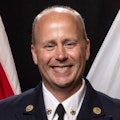Firefighters are more likely to die by suicide than in the line of duty. Let me repeat that: Firefighters are more likely to die by suicide than in the line of duty.
On average, 100 firefighters commit suicide each year. That should be a huge red flag for all fire departments nationwide. The question is, what are you going to do about it?
Symposium
I recently attended the Fire Service Mental Wellness and Suicide Prevention Symposium in Nashville, TN, which was organized by the First Responder Center for Excellence (FRCE) and the National Fallen Firefighters Foundation. (Thank you to Frank Leeb, who is the managing director of the FRCE, for hosting the critical event.)
The symposium brought together some of America’s top clinicians, doctors and fire service professionals. That’s where I determined that suicide discussions still are a heavy lift for many fire departments. Over the one-and-a-half days of the event, I couldn’t help but think about how we can prevent such deaths.
Two resounding themes of the symposium were building trust with your people and the importance of your words. When was the last time that you thanked your staff? The power of saying, “Thank you,” and kind words goes a long way.
Trust isn’t one of those things that’s gained easily. It takes continual work. I recall many times asking a coworker, “How are things going?” Often, the discussion that resulted went in a whole different direction than what I expected. You never know what your people are thinking about or going through. Checking in on your people is paramount.
When things changed for me
I just returned from an EMS call and was in my office completing paperwork. In walked a friend from the local ambulance agency, who closed my door and said, “We need to talk.” I thought something had happened on the call that we were just on when he said something that I never will forget. He said, “Don Premo killed himself.” I couldn’t believe what I just heard. Everything went quiet. My thoughts immediately went to his fiancée and son, who was a little boy at the time. How were they going to go on without him?
What confused me was that Don was at the fire station earlier that day, just stopping by to see what was happening. I was told that he wanted to talk with me, but I was out of the station at the time and never got to speak with him.
The days and weeks that followed Donnie’s death were awful, to say the least. Within the department, people experienced a range of emotions, from anger to sadness. Unfortunately, there were no answers to why Donnie did this to himself. Donnie was a guy who was full of life and always had a big smile. Never in a million years did I think that Donnie would take his own life.
I wish that I had been able to talk with him that day.
Donnie’s memory always will be with me.
Golden Gate Bridge
One of the discussions during the symposium that I found very interesting was the study on the suicide rate at the Golden Gate Bridge in San Francisco. Over the past 20 years, on average, there were 30 confirmed suicides at the bridge annually. Many people had expressed the need for some kind of netting along each side of the bridge to deter people from committing suicide.
The argument against netting was twofold. First, the netting was deemed too expensive, and second, if people see the prevention netting, they will just go and commit suicide in a different way.
According to the American Journal of Psychiatry, a worldwide study was completed regarding popular common places where people committed suicide, the installation of suicide-prevention barriers and people finding different places to commit suicide after barriers were installed. It was found that after suicide barriers were installed, suicide rates at those locations dropped to nearly zero. It also was found that suicide rates at nearby places where it was just as easy to do the same thing didn’t increase and, in some cases, decreased. The data proved that barriers are an effective way to prevent suicide.
On Jan. 1, 2024, construction on barriers on each side of the Golden Gate Bridge was completed, at the cost of $224 million.
What can we do?
Fire service leaders must get in front of suicide issues. If the fire service isn’t willing to have difficult conversations regarding suicide, we never will be able to move the needle in a positive direction.
From my personal experience, I understand that these aren’t comfortable conversations. I went through a department suicide, and the leadership wasn’t comfortable with any of the circumstances that surrounded it.
These are real struggles, and I am sure that many of you and your departments face similar challenges.
What is the answer? Begin by having discussions with your people, to see how they are doing. Be willing to meet them where they are, cognitively and emotionally, not where you want them to be. Build trust and relationships with your people.
Have a plan when someone in your organization says that they are thinking about committing suicide. Understand that we aren’t clinicians or doctors, and having someone tell us that they are thinking of committing suicide is a pretty heavy lift. However, t isn’t about having all of the answers or solving the problem. It’s about listening and connecting people with the right professionals, such as mental health specialists.
If you or someone who you know is facing mental health struggles, emotional distress, alcohol or drug use concerns, or just needs someone to talk to, please dial 9-8-8 for the Suicide and Crisis Lifeline. You aren’t alone.
About the Author

Timothy Cowan
Timothy S. Cowan is a deputy fire chief with the Dewitt Fire District in Central New York and a 32-year fire and emergency services veteran. He retired as a deputy fire chief/fire marshal from the City of Oneida, NY, Fire Department. Cowan also is an active volunteer firefighter with the Canastota, NY, Fire Department. He is a deputy fire coordinator and fire instructor for the Madison County, NY, Office of Emergency Management. He is a NFPA 1030: Standard for Professional Qualifications for Fire Prevention Program Positions Technical Committee - Life Safety Educator member. Cowan is active with the National Fallen Firefighters Foundation and is currently the Region 2 Advocate Manager for the Everyone Goes Home program. He is an Executive Fire Officer Program graduate at the National Fire Academy. He earned an associate degree in Fire and Emergency Services and a Bachelor’s degree in Fire and Emergency Management, both from the State University of New York at Empire State. Cowan is a Fire Officer, Fire Marshal designee, and peer reviewer for the Center of Public Safety Excellence. He is also a Fire Service Occupational Cancer Alliance committee member for the First Responder Center for Excellence.


